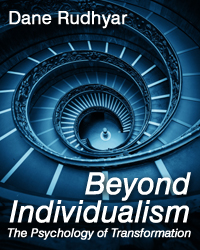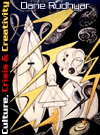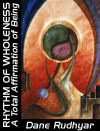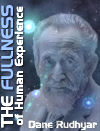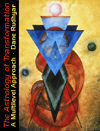Beyond Individualism
The Psychology of Transformation
by Dane Rudhyar
PART ONE:
THE PERSONAL-INDIVIDUAL MODE
2. The Four Orders of Functions
b. Functions of the Second Order
Existence is based on relatedness. Life cannot exist without some kind of relationship. All the basic biological functions imply specific forms of relationship in which a living organism either absorbs various inorganic substances (air, water, minerals) or eats and assimilates other living organisms and their products (for instance, fruits and seeds). Eating is a fundamental biological need. The law of the biosphere is: Eat or be eaten. Hunger is a relentless drive related to the 'nutritive function'. The need for security produces another kind of drive based on the operation of the function of organic preservation and self-maintenance which especially manifests as the capacity to defend oneself against other organisms or natural forces. These three functions of the first order imply relationship with other organisms. Eating means being related in a special manner with what is being eaten. Sexual activity, at the instinctual and natural level, requires a partner of opposite biological polarity. Security at the jungle state of existence in most instances demands the co-operation of several living organisms, according to the adage, "In union there is strength."
At the strictly biological level of activity, the living organism uses relationship to fulfill what its functional activities need in order to operate as well as possible; but when the factor of relatedness is given a significance and value that in some manner imbues the activity with a character transcending the strictly biological need, functions of the second order can be said to appear. They display a new operational quality and therefore produce (or induce) a new type of consciousness—social consciousness.
Social consciousness evidently exists at the animal level; yet it most likely does not reach the stage of autonomous development until the activities of human beings, living in rather clearly defined and relatively permanent groups, become differentiated —some human beings becoming specialists in a particular field of activity, others in another field. The most basic differentiation is at first purely biological, being the inevitable result of differences between male and female types of sexual and procreative activity. It implies also the difference between children and adults, a difference which in tribal groups, to some extent at least, is eradicated by the sacred rites of puberty. As the evolution of tribal societies proceeds, clans or specialized groups develop, each being charged with the responsibility of satisfying a particular functional need of the society-as-a-whole. This eventually leads to the establishment of castes and social classes.(1)
The important point is, that at first the formation of differentiated groups of human beings within a tribal collectivity is purely a projection of the biological functions upon a but rudimentary and undeveloped layer of consciousness. Biological functions operate in a condition we today call 'unconsciousness', even though a subhuman kind of consciousness should be attributed to cells and perhaps to the physical-body-as-a-whole (we speak now, at least figuratively, of the "wisdom of the body"). Consciousness, in the present-day ordinary sense of the term, develops with social processes, because it is based on the emergence and the progressive ascendancy of the sense of relatedness, gradually detaching itself from its biological base.
As human beings in tribal groups begin to cultivate this sense of togetherness and relatedness, above and beyond the fulfillment of strictly biological needs, social functions develop which seek to give to the fact of group-relationship a collective meaning. This meaning in turn, by increasing the cohesion of the group, makes the group activity more efficacious. But this increase in effectiveness is presented as subservient to a 'higher' realization, that of the 'unity' of the group. At least it is so presented by a special kind of human beings—medicine-men, seers, high priests, and later, philosophers—whose social function it is to give to this sense of unity in relatedness a religious and cultural formulation. The newly developed social function is glorified and projected as an existential—even though supernal and mysterious—reality, the god of the tribe. It finds its actional and concretized manifestation in rituals, myths and symbols, and thus a particular culture is born.
Functions of the second order are socio-cultural, and the most basic of them answers the need for communication. This need is met by the development of various types of language. There is a language of gestures, a language using relatively isolated onomatopoeic vocal sounds to evoke collective experiences, and a language describing and defining actional processes through verbs, nouns, qualificatives suggesting existential qualities, and connective terms referring to the relation between all the various factors.
These forms of communication develop, on the one hand, into symbolic art-forms evoking intangible, subjective feelings or realizations rather than describing the interaction of physical entities, and on the other hand, into various systematized forms of mental activities. These essentially have the character of 'revelation'. Life, or the god who controls all the life processes, reveals to the more sensitive human organisms whatever knowledge they need, not only to physically survive, but to bring to the fullest possible development a particular quality of human existence, activity and consciousness characterizing the communal group to which it is addressed.
From language and various forms of revealed types of activity presented as unbreakable taboos or divine commandments, socio-cultural institutions develop which further concretize and crystallize the sense of relatedness and tribal (later social) interdependence. These institutions increasingly bind together, and mentally as well as emotionally integrate, the participants into a collective culture-whole. A culture-whole can be considered a socio-cultural organism in the sense that it is an organized system (or field) of interrelated and interdependent human activities, integrated by a deep-seated feeling of community and a commonness of traditions and basic purpose. Culture-wholes are originally most closely related to, and even identified with, a clearly defined geographical territory, a particular climate, a special fauna and flora, and resources of various kinds. The culture-whole is 'rooted' in the biosphere and to this extent it is based on functions of the first order which give it a solidity— the solidity of rootedness. But, as already stated, if biology is the root, the socio-cultural activity represents the foliage. The tree of human collectivity eventually blossoms forth into individual persons.
Culture does not deny biology; it differentiates and refines biological activity, reorienting and controlling it, so as to stabilize and extend it. This makes far more complex and, above all, more consciously meaningful, the interaction and interdependence of the many members of a social organism; and this, not only within a spatial field, but throughout the entire life-span of that organism, the span of many centuries. Here we come to what differentiates human from animal societies. A human society is not merely concerned with the satisfaction of a collective need for security and steady growth; it also is intent on developing conditions of living and a state of consciousness allowing for the peaceful transfer of information, knowledge, meaning, and purpose from generation to generation. The value of such a transfer of culture parallels, at a non-physical level, the importance of genetic selection and of producing relatively stable lines of genetic development at the biological level. To use a significant phrase coined more than fifty years ago by Count Alfred Korzybski in his early book, The Manhood of Humanity, man has a "time-binding" capacity—while animals, thanks to their ability for locomotion, 'bind space', and plants 'bind chemical elements', particularly in photosynthesis.
The time-binding capacity implies the ability to produce symbols which not only carry concrete and eventually technical information in the form of words and glyphs or diagrams of various types, but may also convey meaning and a quality of understanding, from which wisdom can emerge as a guiding force for future generations. At first, symbols are almost entirely based on the common biological, seasonal and agricultural experience of the human beings belonging to a particular culture-whole (or society), but they gradually assume an abstract character, referring no longer as much to the character and behavior of physical entities and forces of nature as to the relationship between entities or the acts they perform. These relationships produce not only physically observable results, but also subjective feelings— whether in individual persons or in large groups.
Knowledge born of accumulated observations and experiments, and of the classification and generalization of these data, leads to the growth of a mental attitude which is not only objective, but at least potentially transformative. Wisdom, likewise, can act as a transformative force, for events—whether present, expected, or past—can be transformed by the meaning given to them. Such transformations raise the consciousness to' a higher vibratory pitch. The circularity and repetitiveness of biological instincts becomes, as a result, the spiral of conscious human evolution.
The question of whether animals have 'intelligence' or only 'instincts' is perhaps more semantic than realistic, though the great French philosopher, Henri Bergson, whose ideas had a tremendous influence during the first part of our century, stressed what to him was a basic difference between the two words. Yet, not only in animals, but as well in the primitive human, mind operates exclusively at the service of the biological needs for survival, security and food. 'Life' totally controls 'mind'. Mind, however, can free itself from such a control, because mind is simply consciousness in a formed (or structured) state. It is consciousness stabilized and defined at a particular level of activity. When the level of activity of an existential whole—and therefore of the consciousness associated with this activity—changes, the mind, which is a part of this whole, becomes transformed.
As already stated and more extensively formulated in my book The Planetarization of Consciousness, consciousness is simply another aspect of wholeness. The existence of an existential whole implies a particular inner organization of its parts or components; and this organization, in turn, implies some degree of consciousness. Every existential whole is in a process of change. It is both internally and externally active. Activity implies an expenditure of potential energy. Thus, all these terms—activity, energy, wholeness, organization, and consciousness—are interdependent aspects of the same reality; i.e., of the complex, rhythmic, and ordered process we call existence. What has to be considered is the level at which the existential process operates. Difference of level of activity implies difference of vibratory frequency (in terms of energy release) and difference in the character and scope, the quality and inclusiveness of the consciousness.
Thus, when the human organism operates almost exclusively at the level of 'life', its consciousness has the character and quality of biological activity and biological functions. Life, in the strict sense of biological activity on the Earth's surface, operates in terms of physicality, that is, it deals with and organizes materials which have a great deal of mass and inertia. Life at the level of the vegetable and animal kingdoms manifests in and through material bodies constituting organized fields of essentially physical activity, with a low rate of vibratory frequency and a great deal of resistance to change and 'acceleration' or intensification. But at the human level, while life's operation is still basically conditioned by the physicality of the human body, a new and 'higher' potentiality begins to operate.
This potentiality of rhythmic transformation and intensification of consciousness at first operates in a most tentative and imprecisely focused manner; it is constantly overwhelmed by the powerful rhythms and demands of the biological functions. Yet it is inherent in any human organism. By its very presence, it acts in a deep subconscious manner at the core of every human organism; and the essential function of 'culture' (in the highest and most human sense of the word) is to cradle the actualization of this new potentiality.
If used in its broadest meaning, the term 'society' applies to the level of animal as well as human activity; but at the animal level, society is totally dominated by the physicality of biological functions. As humanity gradually and more clearly defines its 'humanness' and raises the focus of its collective consciousness to an ever-higher level, human societies gradually respond to the vibration of a new level of existential activity. Cultural activities and institutions which at first were still entirely pervaded with biological motivation, progressively—yet hesitantly —attempt to incorporate qualities belonging to a transphysical level of consciousness. Culture becomes impregnated with what I have defined as the process of 'civilization'. I use this word in its most inclusive sense, a sense which accounts for its present negative and catabolic aspect in our megalopoles; but it also includes the ideal aspect symbolized in esoteric tradition by the "Holy City", Hieros Salem (the sacred place of Peace), or the future Shambhala that stands in relation to the ancient Shambhala as the Omega to the Alpha state of human evolution.(2)
Human culture takes on a more strictly 'human' character when the symbols it creates are interrelated to constitute an ever more abstract, and therefore less physically concrete (and even less biologically conditioned), type of 'language'; this is the language of modern science, thanks to whose information technology has developed with intensely transformative results. In a sense, this is the language of 'civilization', and it finds its ultimate expression in mathematics, with its group-algebra and its ever more rarefied concepts of multidimensions and time-reversal which seek to transcend the most basic experiences of human existence, that of directional change. The use of mathematics in the interpretation of indirectly observed sub-atomic phenomena has led to a transphysical and superrational relativistic picture of the universe.
As Fritjof Capra points out in his already-mentioned book, The Tao of Physics, such a picture is strikingly similar to those which Oriental and Western mystics and seers have sought to evoke through the use of paradoxes intending to challenge and confuse or break down the mind bound to concrete phenomena and rationalistic sequences. Erotic symbols have also frequently been used to draw the too-personalized consciousness to the rare life-moments when the everyday sense of ego-separateness is most likely to be swept away by a unifying tide of emotional intensity.
What this means is that the development of culture may have to take different forms in different places in order to produce essentially similar results. The ultimate aim of human evolution is the raising of the focus of consciousness and, as a result (or at the same time), the freeing of human activity from its bondage to physicality and biology by providing for it new channels of expression. If modern science, mathematics, and the transcendent vistas of atomic physics and intergalactic astronomy have today come to occupy a place of dominant influence in a world largely controlled by our Western type of mentality, it is because this influence was needed to cope with the rapid development, especially in Europe and America, of the new functions of the third order related to the process of individualization.
Since the sixth century B. C., and especially since the European Renaissance, this process has accelerated to such an extent that it has given rise to critical social and cultural tensions and conflicts, and to endless personal problems. These social conflicts and psychological problems have to be faced with a holistic type of understanding; and I believe that such an understanding can best be gained when the elements of our present world-crisis are approached and evaluated in terms of the sequential development of the four orders of functions and their interaction within the field of the individual person and—as we shall later see—of a culture-whole such as ours
1. Such a functional differentiation is very marked in the societies of ants and bees, but the extent to which it affects the consciousness of the units in the differentiated groups is unknown. Return
2. For a full discussion of the concepts of culture and civilization, see my book, Culture, Crisis and Creativity (Wheaton: Theosophical Publishing House, 1977). Return
Functions of the Third Order
Copyright © 1979 by Dane Rudhyar.
All Rights Reserved.
See Notices for full copyright statement and conditions of use.
Web design copyright © 2000-2004 by Michael R. Meyer.
All Rights Reserved.


